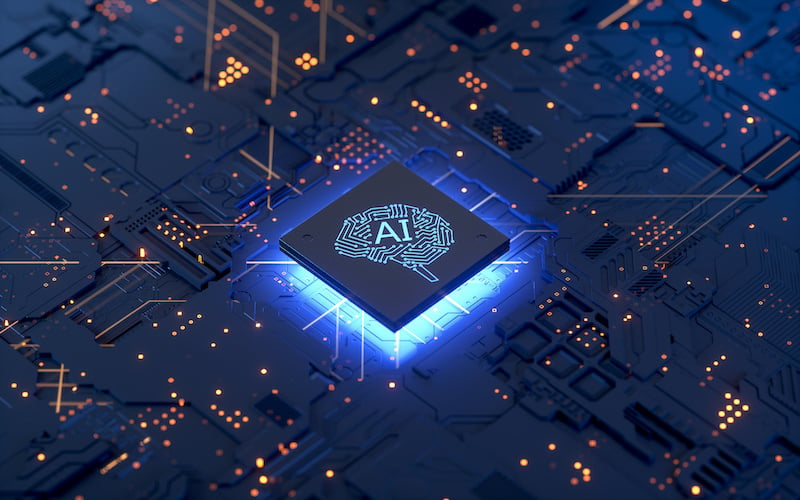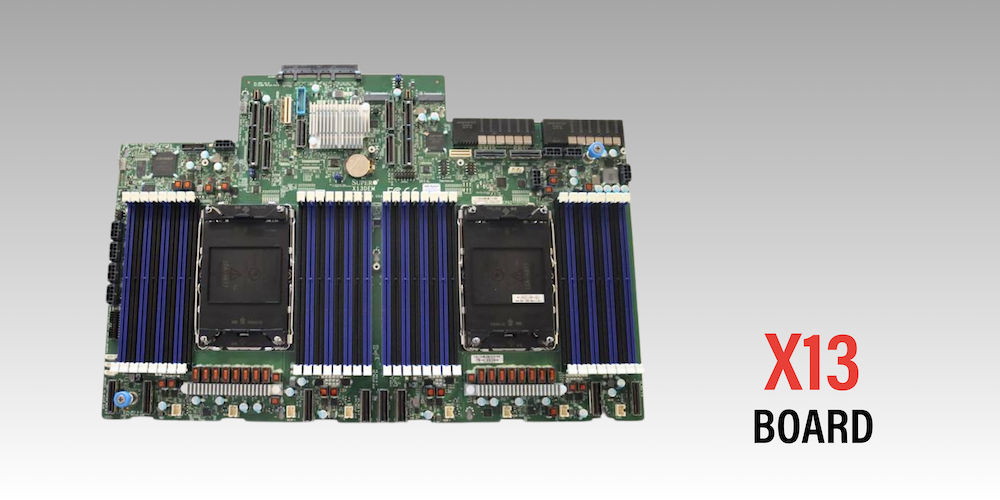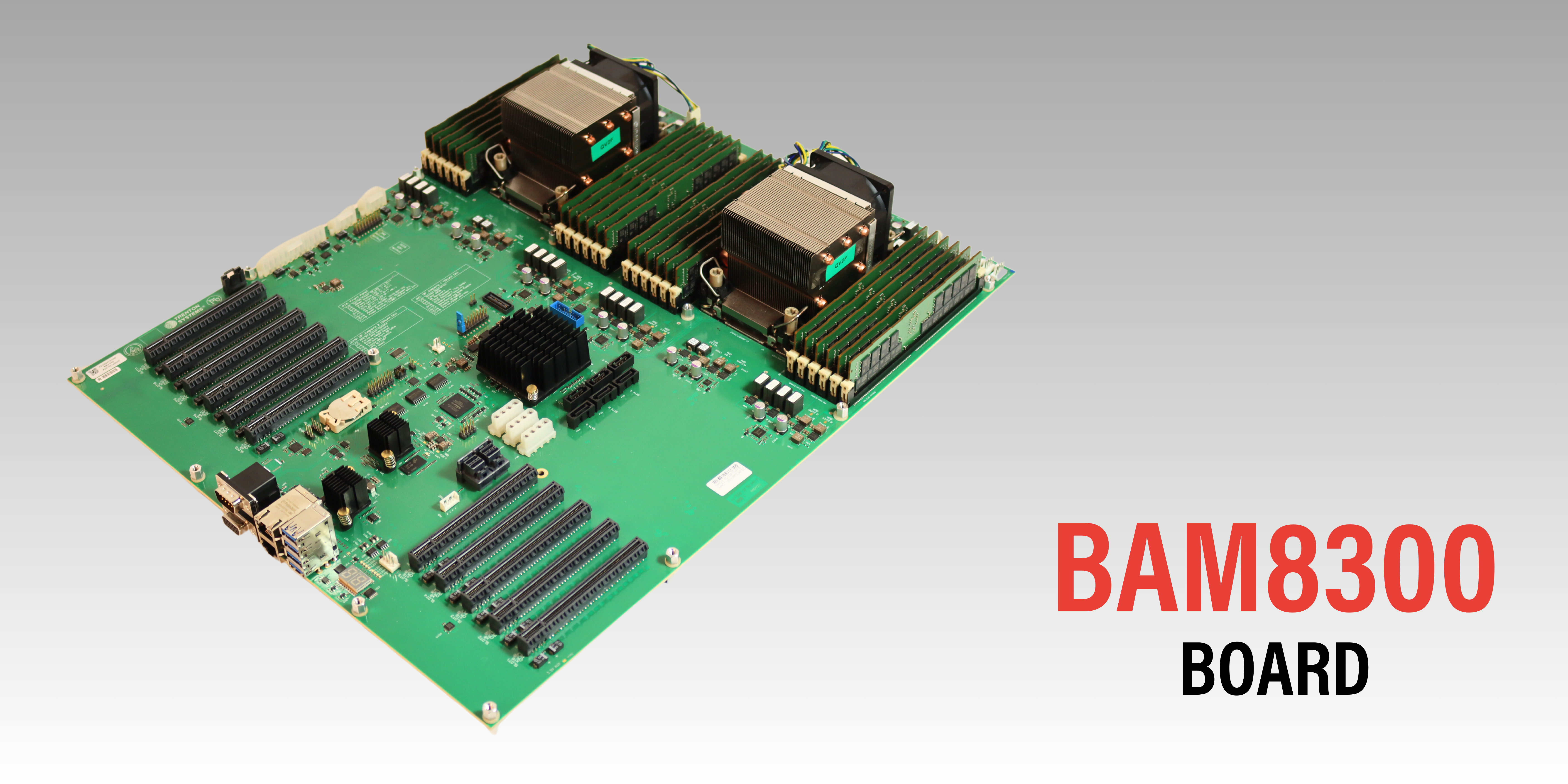Share this
Intelligent Innovation: AI-Powered Solutions for Complex Applications
by Christopher Trick on Feb 8, 2024 8:30:54 AM

AI (artificial intelligence) is surging in popularity and importance within the world of HPC (high-performance computing) due to its ability to quickly process and analyze large data sets to deliver real-time, actionable intelligence for a variety of applications.
In this blog, we take a look at some of AI's key benefits, how a solution becomes AI-powered, motherboard form factors that support advanced AI/ML/DL, use cases, and two AI-powered solutions from Trenton Systems.
The rise of AI in high-performance computing
High-performance computing workloads have evolved beyond what CPUs (central processing units) can traditionally handle by themselves. An increasing amount of available data, coupled with complex algorithms and simulations, have promoted the need for increased computational power, efficiency, and scalability.
Additionally, this exponential growth in data generation across various fields has created a pressing need for computing solutions that can quickly process and analyze this vast amount of information in real-time. This data can then be used to develop algorithms that can perform complex tasks.
Artificial intelligence (AI) techniques such as parallel processing and inferencing, and machine learning (ML) and deep learning (DL) techniques such as training, excel at extracting meaningful insights from large datasets as well as recognizing patterns and making predictions with a limited amount of programming.
How does a solution become AI-powered?
There is a growing trend towards heterogeneous computing architectures in the HPC space, where CPUs are complemented with option cards to meet the demands for increased computational power, efficiency, and scalability.
Specialized option cards like GPUs (Graphics Processing Units) and FPGAs (Field-Programmable Gate Arrays) can play a pivotal role in enhancing a system's AI/ML/DL capabilities.
These cards leverage the high-speed connectivity of PCIe slots and the CXL (Compute Express Link) interface to communicate with the CPU and ensure coherency to enable faster computations, reduce latency, and deliver real-time actionable intelligence.
GPUs are renowned for their parallel processing, inferencing, and rendering capabilities, making them indispensable for training deep neural networks, a cornerstone of many AI applications. GPUs enhance system performance by offloading computationally intensive tasks from the CPU to the GPU, thus accelerating AI workloads.
On the other hand, FPGAs offer a unique advantage in AI applications due to their reconfigurability, allowing for custom hardware acceleration tailored to specific algorithms or tasks. This enables flexible and efficient processing of diverse AI workloads, offering the potential for significant performance gains and power efficiency compared to traditional CPU-based solutions.
Incorporating these option cards into next-gen PCIe slots ensures scalability and versatility in AI infrastructure, empowering organizations to build powerful, customizable AI systems tailored to their specific requirements and performance demands.
Additionally, this allows HPC solutions to tackle diverse workloads more effectively and efficiently than relying solely on CPUs.

Motherboard Configurations
Both standard and non-standard motherboard form factors harness the power of AI for on-premise, cloud, and edge workloads across a wide range of industries.
Let's look at two of the latest motherboards integrated into scalable, secure, and edge-ready AI-powered solutions: the Supermicro® X13 and the Trenton BAM8300.
Standard: Supermicro® x13
The Supermicro® X13 board is a standard motherboard form factor that is readily available for integration into rack mount servers, allowing you to incorporate the latest technologies as they become available.
This, in turn, greatly reduces time to market, ensuring timely delivery and keeping programs of record on schedule.
The Supermicro® X13 board supports MCIO connectors, providing modularity, scalability, and interoperability that allow you to quickly add or remove option cards to meet the performance demands of your application or program.
This allows you to fit as many or as few option cards as you need within different rack unit heights without having to change motherboard configurations.
This motherboard also has an OCP port to support OCP option cards. OCP is a standard small form factor for hardware components--including accelerators, GPUs, and NIC cards--that helps increase flexibility, avoid vendor-lock in, and reduce total cost of ownership for server and/or network infrastructure.
Additionally, the SMBus (System Management Bus) actively monitors components on the motherboard to deliver instant updates on system performance.

Non-Standard: Trenton BAM8300
The Trenton BAM8300 board is a non-standard motherboard form factor that is designed in consultation with our internal teams per customer specifications.
This board is designed, manufactured, assembled, tested, and supported in the United States of America within a vetted and transparent supply chain.
Each component is tracked, traced, and vetted down the resistor level, increasingly flexibility in board design while reducing costs.
Additionally, the BIOS source code is fully customized to eliminate firmware vulnerabilities and tailor system performance to customer specifications.

What do these boards have in common?
Both the Supermicro® X13 and the Trenton BAM8300 boards are powered by 4th and 5th Gen Intel® Xeon® SP CPUs to deliver high-speed, low-latency processing and throughput. These CPUs deliver up to 84 percent general compute performance improvement over 3rd Gen Intel® Xeon® SP CPUs.
Each CPU serves as a drop-in replacement, offering enhanced performance at the same power envelope, reducing overhead and total cost of ownership.
This delivers large amounts of critical data at faster speeds to NVIDIA high-end Multi-Instance GPUs to accelerate the output of real-time actionable intelligence that helps increase situational awareness and even further reduce response times, enhancing decision-making when and where it matters most.
Additionally, each motherboard supports multiple PCIe 5.0 slots, allowing for increased speeds and feeds as well as expanded I/O capabilities to add or remove option cards to scale performance to meet the demands of complex, evolving workloads.
Use Cases for AI-Powered Solutions
Defense: Ground-Based Stations for SIGINT (Signals Intelligence)
Enhanced AI/ML/DL capabilities are crucial for ground-based stations used in SIGINT operations. These stations collect and analyze electromagnetic signals to gather intelligence on adversarial communication systems, radar systems, and electronic warfare activities.
AI-powered solutions crunch vast amounts of intercepted data in real-time, enabling rapid identification of patterns, anomalies, and potential adversarial threats. This enhances SIGINT operations by automating signal analysis and providing actionable insights to military and intelligence agencies that bolster national security.

Industrial: Oil and Gas
AI/ML/DL plays a vital role in pipeline monitoring systems for the oil and gas industry. These systems are designed to detect leaks, prevent environmental damage, and ensure the integrity of pipelines.
Pipeline networks transport oil, gas, and other hazardous substances over long distances, making them vulnerable to leaks, corrosion, and sabotage. Timely detection and response to these incidents are critical to preventing accidents and minimizing environmental impact.
AI-powered solutions process data from various sensors, including pressure, temperature, flow rate, and acoustic sensors, to analyze patterns indicative of leaks or structural weaknesses.
By continuously monitoring the pipeline infrastructure, these solutions enable early detection of abnormalities, triggering alerts and facilitating swift intervention to mitigate risks and ensure operational safety.

Commercial: Ultrasound Imaging
Ultrasound imaging systems utilize AI/ML/DL for various purposes, including medical diagnostics, monitoring, and guidance during operations.
Ultrasound imaging utilizes high-frequency sound waves to produce real-time images of a patient's current condition without needing invasive procedures.
AI-powered solutions analyze large amounts of ultrasound data to enhance image quality, detect abnormalities, and provide insights into the scanned objects or tissues. This, in turn, helps increase the speed, availability, and quality of patient care.

AI-Powered Solutions from Trenton Systems: 1U and 2U Rugged Servers

Trenton Systems' 1U and 2U Rugged Servers are compact, flexible, and zero trust architected AI/ML/DL powerhouses with the latest high-performance computing technologies that deliver enhanced operational efficiency for the defense, government, industrial, and commercial markets.
These servers are readily deployable, supporting standard and non-standard motherboard form factors that can easily scale to meet the demands of your application or program without major changes to system infrastructure.
"With design versatility, we can get our solutions into customers’ hands even quicker while incorporating next-gen technologies as they become available. This allows the customer to fully vet and test our solutions, providing us with valuable feedback we need to further tailor our approach to meet their application or program needs."
 Cody Bickford, Technical Director at Trenton Systems
Cody Bickford, Technical Director at Trenton SystemsAdditionally, these servers are tested to stringent military standards and comply with the latest quality management certifications to ensure operational efficiency and prevent equipment failure within harshest of environments.
If you are looking for something more custom, our sales, engineering, and product development teams will work closely with you to craft a solution that fulfills your most complex technical, performance, and environmental requirements.
Interested in learning more? Reach out to a member of our team anytime here. We're more than happy to help. 🙂
Share this
- High-performance computers (42)
- Military computers (38)
- Rugged computers (32)
- Cybersecurity (25)
- Industrial computers (25)
- Military servers (24)
- MIL-SPEC (20)
- Rugged servers (19)
- Press Release (17)
- Industrial servers (16)
- MIL-STD-810 (16)
- 5G Technology (14)
- Intel (13)
- Rack mount servers (12)
- processing (12)
- Computer hardware (11)
- Edge computing (11)
- Rugged workstations (11)
- Made in USA (10)
- Partnerships (9)
- Rugged computing (9)
- Sales, Marketing, and Business Development (9)
- Trenton Systems (9)
- networking (9)
- Peripheral Component Interconnect Express (PCIe) (7)
- Encryption (6)
- Federal Information Processing Standards (FIPS) (6)
- GPUs (6)
- IPU (6)
- Joint All-Domain Command and Control (JADC2) (6)
- Server motherboards (6)
- artificial intelligence (6)
- Computer stress tests (5)
- Cross domain solutions (5)
- Mission-critical servers (5)
- Rugged mini PCs (5)
- AI (4)
- BIOS (4)
- CPU (4)
- Defense (4)
- Military primes (4)
- Mission-critical systems (4)
- Platform Firmware Resilience (PFR) (4)
- Rugged blade servers (4)
- containerization (4)
- data protection (4)
- virtualization (4)
- Counterfeit electronic parts (3)
- DO-160 (3)
- Edge servers (3)
- Firmware (3)
- HPC (3)
- Just a Bunch of Disks (JBOD) (3)
- Leadership (3)
- Navy (3)
- O-RAN (3)
- RAID (3)
- RAM (3)
- Revision control (3)
- Ruggedization (3)
- SATCOM (3)
- Storage servers (3)
- Supply chain (3)
- Tactical Advanced Computer (TAC) (3)
- Wide-temp computers (3)
- computers made in the USA (3)
- data transfer (3)
- deep learning (3)
- embedded computers (3)
- embedded systems (3)
- firmware security (3)
- machine learning (3)
- Automatic test equipment (ATE) (2)
- C6ISR (2)
- COTS (2)
- COVID-19 (2)
- CPUs (2)
- Compliance (2)
- Compute Express Link (CXL) (2)
- Computer networking (2)
- Controlled Unclassified Information (CUI) (2)
- DDR (2)
- DDR4 (2)
- DPU (2)
- Dual CPU motherboards (2)
- EW (2)
- I/O (2)
- Military standards (2)
- NVIDIA (2)
- NVMe SSDs (2)
- PCIe (2)
- PCIe 4.0 (2)
- PCIe 5.0 (2)
- RAN (2)
- SIGINT (2)
- SWaP-C (2)
- Software Guard Extensions (SGX) (2)
- Submarines (2)
- Supply chain security (2)
- TAA compliance (2)
- airborne (2)
- as9100d (2)
- chassis (2)
- data diode (2)
- end-to-end solution (2)
- hardware security (2)
- hardware virtualization (2)
- integrated combat system (2)
- manufacturing reps (2)
- memory (2)
- mission computers (2)
- private 5G (2)
- protection (2)
- secure by design (2)
- small form factor (2)
- software security (2)
- vRAN (2)
- zero trust (2)
- zero trust architecture (2)
- 3U BAM Server (1)
- 4G (1)
- 4U (1)
- 5G Frequencies (1)
- 5G Frequency Bands (1)
- AI/ML/DL (1)
- Access CDS (1)
- Aegis Combat System (1)
- Armed Forces (1)
- Asymmetric encryption (1)
- C-RAN (1)
- COMINT (1)
- Cloud-based CDS (1)
- Coast Guard (1)
- Compliance testing (1)
- Computer life cycle (1)
- Containers (1)
- D-RAN (1)
- DART (1)
- DDR5 (1)
- DMEA (1)
- Data Center Modular Hardware System (DC-MHS) (1)
- Data Plane Development Kit (DPDK) (1)
- Defense Advanced Research Projects (DARP) (1)
- ELINT (1)
- EMI (1)
- EO/IR (1)
- Electromagnetic Interference (1)
- Electronic Warfare (EW) (1)
- FIPS 140-2 (1)
- FIPS 140-3 (1)
- Field Programmable Gate Array (FPGA) (1)
- Ground Control Stations (GCS) (1)
- Hardware-based CDS (1)
- Hybrid CDS (1)
- IES.5G (1)
- ION Mini PC (1)
- IP Ratings (1)
- IPMI (1)
- Industrial Internet of Things (IIoT) (1)
- Industry news (1)
- Integrated Base Defense (IBD) (1)
- LAN ports (1)
- LTE (1)
- Life cycle management (1)
- Lockheed Martin (1)
- MIL-S-901 (1)
- MIL-STD-167-1 (1)
- MIL-STD-461 (1)
- MIL-STD-464 (1)
- MOSA (1)
- Multi-Access Edge Computing (1)
- NASA (1)
- NIC (1)
- NIC Card (1)
- NVMe (1)
- O-RAN compliant (1)
- Oil and Gas (1)
- Open Compute Project (OCP) (1)
- OpenRAN (1)
- P4 (1)
- PCIe card (1)
- PCIe lane (1)
- PCIe slot (1)
- Precision timestamping (1)
- Product life cycle (1)
- ROM (1)
- Raytheon (1)
- Remotely piloted aircraft (RPA) (1)
- Rugged computing glossary (1)
- SEDs (1)
- SIM Card (1)
- Secure boot (1)
- Sensor Open Systems Architecture (SOSA) (1)
- Small form-factor pluggable (SFP) (1)
- Smart Edge (1)
- Smart NIC (1)
- SmartNIC (1)
- Software-based CDS (1)
- Symmetric encryption (1)
- System hardening (1)
- System hardening best practices (1)
- TME (1)
- Tech Partners (1)
- Total Memory Encryption (TME) (1)
- Transfer CDS (1)
- USB ports (1)
- VMEbus International Trade Association (VITA) (1)
- Vertical Lift Consortium (VLC) (1)
- Virtual machines (1)
- What are embedded systems? (1)
- Wired access backhaul (1)
- Wireless access backhaul (1)
- accredidation (1)
- aerospace (1)
- air gaps (1)
- airborne computers (1)
- asteroid (1)
- authentication (1)
- autonomous (1)
- certification (1)
- cognitive software-defined radios (CDRS) (1)
- command and control (C2) (1)
- communications (1)
- cores (1)
- custom (1)
- customer service (1)
- customer support (1)
- data linking (1)
- data recording (1)
- ethernet (1)
- full disk encryption (1)
- hardware monitoring (1)
- heat sink (1)
- hypervisor (1)
- in-house technical support (1)
- input (1)
- integrated edge solution (1)
- international business (1)
- licensed spectrum (1)
- liquid cooling (1)
- mCOTS (1)
- microelectronics (1)
- missile defense (1)
- mixed criticality (1)
- moving (1)
- multi-factor authentication (1)
- network slicing (1)
- neural networks (1)
- new headquarters (1)
- next generation interceptor (1)
- non-volatile memory (1)
- operating system (1)
- output (1)
- outsourced technical support (1)
- post-boot (1)
- pre-boot (1)
- private networks (1)
- public networks (1)
- radio access network (RAN) (1)
- reconnaissance (1)
- rugged memory (1)
- secure flash (1)
- security (1)
- self-encrypting drives (SEDs) (1)
- sff (1)
- software (1)
- software-defined radios (SDRs) (1)
- speeds and feeds (1)
- standalone (1)
- storage (1)
- systems (1)
- tactical wide area networks (1)
- technical support (1)
- technology (1)
- third-party motherboards (1)
- troposcatter communication (1)
- unlicensed spectrum (1)
- volatile memory (1)
- vpx (1)
- zero trust network (1)
- January 2025 (1)
- November 2024 (1)
- October 2024 (1)
- August 2024 (1)
- July 2024 (1)
- May 2024 (1)
- April 2024 (3)
- February 2024 (1)
- November 2023 (1)
- October 2023 (1)
- July 2023 (1)
- June 2023 (3)
- May 2023 (7)
- April 2023 (5)
- March 2023 (7)
- December 2022 (2)
- November 2022 (6)
- October 2022 (7)
- September 2022 (8)
- August 2022 (3)
- July 2022 (4)
- June 2022 (13)
- May 2022 (10)
- April 2022 (4)
- March 2022 (11)
- February 2022 (4)
- January 2022 (4)
- December 2021 (1)
- November 2021 (4)
- September 2021 (2)
- August 2021 (1)
- July 2021 (2)
- June 2021 (3)
- May 2021 (4)
- April 2021 (3)
- March 2021 (3)
- February 2021 (8)
- January 2021 (4)
- December 2020 (5)
- November 2020 (5)
- October 2020 (4)
- September 2020 (4)
- August 2020 (6)
- July 2020 (9)
- June 2020 (11)
- May 2020 (13)
- April 2020 (8)
- February 2020 (1)
- January 2020 (1)
- October 2019 (1)
- August 2019 (2)
- July 2019 (2)
- March 2019 (1)
- January 2019 (2)
- December 2018 (1)
- November 2018 (2)
- October 2018 (5)
- September 2018 (3)
- July 2018 (1)
- April 2018 (2)
- March 2018 (1)
- February 2018 (9)
- January 2018 (27)
- December 2017 (1)
- November 2017 (2)
- October 2017 (3)
/Trenton%20Systems%20Circular%20Logo-3.png?width=50&height=50&name=Trenton%20Systems%20Circular%20Logo-3.png)
Comments (4)